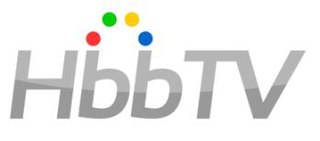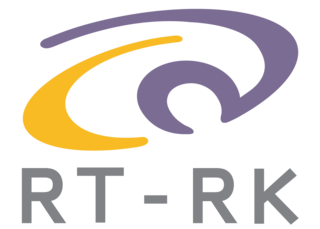
In computer networking, multicast is group communication where data transmission is addressed to a group of destination computers simultaneously. Multicast can be one-to-many or many-to-many distribution. Multicast should not be confused with physical layer point-to-multipoint communication.

Digital Video Broadcasting (DVB) is a set of international open standards for digital television. DVB standards are maintained by the DVB Project, an international industry consortium, and are published by a Joint Technical Committee (JTC) of the European Telecommunications Standards Institute (ETSI), European Committee for Electrotechnical Standardization (CENELEC) and European Broadcasting Union (EBU).
Digital terrestrial television is a technology for terrestrial television where television stations broadcast television content in a digital format. DTTV is a major technological advance over analog television, and has largely replaced analog television broadcast, which had been in common use since the middle of the 20th century. Test broadcasts began in 1998 with the changeover to DTTV, also known as the Analog Switchoff (ASO) or Digital Switchover (DSO), which began in 2006 and is now complete in many countries. The advantages of digital terrestrial television are similar to those obtained by digitizing platforms such as cable TV, satellite, and telecommunications: more efficient use of radio spectrum bandwidth, provision of more television channels than analog, better quality images, and potentially lower operating costs for broadcasters.

Internet Protocol television (IPTV) is the delivery of television content over Internet Protocol (IP) networks. This is in contrast to delivery through traditional terrestrial, satellite, and cable television formats. Unlike downloaded media, IPTV offers the ability to stream the source media continuously. As a result, a client media player can begin playing the content almost immediately. This is known as streaming media.
Datacasting is the broadcasting of data over a wide area via radio waves. It most often refers to supplemental information sent by television stations along with digital terrestrial television (DTT), but may also be applied to digital signals on analog TV or radio. It generally does not apply to data inherent to the medium, such as PSIP data that defines virtual channels for DTT or direct broadcast satellite system, or to things like cable modems or satellite modems, which use a completely separate channel for data.
DVB-H is one of three prevalent mobile TV formats. It is a technical specification for bringing broadcast services to mobile handsets. DVB-H was formally adopted as ETSI standard EN 302 304 in November 2004. The DVB-H specification can be downloaded from the official DVB-H website. From March 2008, DVB-H is officially endorsed by the European Union as the "preferred technology for terrestrial mobile broadcasting". The major competitors of this technology are Qualcomm's MediaFLO system, the 3G cellular system based MBMS mobile-TV standard, and the ATSC-M/H format in the U.S. DVB-SH now and DVB-NGH in the future are possible enhancements to DVB-H, providing improved spectral efficiency and better modulation flexibility. DVB-H has been a commercial failure, and the service is no longer on-air. Ukraine was the last country with a nationwide broadcast in DVB-H, which began transitioning to DVB-T2 during 2019.
Mobile television is television watched on a small handheld or mobile device, typically developed for that purpose. It includes service delivered via mobile phone networks, received free-to-air via terrestrial television stations, or via satellite broadcast. Regular broadcast standards or special mobile TV transmission formats can be used. Additional features include downloading TV programs and podcasts from the Internet and storing programming for later viewing.
IP over DVB implies that Internet Protocol datagrams are distributed using some digital television system, for example DVB-H, DVB-SH, DVB-T, DVB-S, DVB-C or their successors like DVB-T2, DVB-S2, and DVB-C2. This may take the form of IP over MPEG, where the datagrams are transferred over the MPEG transport stream, or the datagrams may be carried in the DVB baseband frames directly, as in GSE.
DVB-T2 is an abbreviation for "Digital Video Broadcasting – Second Generation Terrestrial"; it is the extension of the television standard DVB-T, issued by the consortium DVB, devised for the broadcast transmission of digital terrestrial television. DVB has been standardized by ETSI.
Television in Iceland is currently composed of the public broadcasting service of RÚV, five free-to-view channels and a number of subscription channels provided by private broadcasters. Broadcasts began in 1955 when the American Forces Radio and Television Service (AFRTS) started an English-language television service broadcasting from Naval Air Station Keflavik, which operated until 2006. The first Icelandic-language television broadcasts started in September 1966 with the launch of RÚV, originally called Sjónvarpið. In 1986 the first privately owned TV station, Stöð 2, began broadcasts. In recent years the emergence of foreign internet streaming services such as Netflix and Disney+ has seen shift from domestic providers provide similar on demand streaming services such as Síminn Premium and Stöð 2+.
In Malaysia, digital television broadcasts, DTV or DHD, can be received via cable, internet, satellite, or via free over-the-air (OTA) digital terrestrial television - much like analogue television broadcasts have been. It began in the mid-1990s with the introduction of the Astro satellite television service, now followed by new paid television services in the 2000s, as well as the digitalisation of over-the-air TV which was expected to be complete by the mid-2010s before being shelved. This article discusses various platforms where DTV is applied in Malaysia, including Digital Video Broadcasting (DVB) and Internet Protocol Television (IPTV). Following its successful nationwide digital transition on 31 October 2019, the country became the third in Southeast Asia with digital broadcasts after neighbouring Brunei and Singapore.

The DTG is the association for British digital television broadcasters and annually publish and maintain the technical specifications for digital terrestrial television (DTT) in the United Kingdom, which is known as the D-Book and is used by Freeview, Freeview HD, FreeSat and YouView. The association consists of over 120 UK and international members who can participate in DTG activities to varying degrees, depending on their category of membership.

MagtiCom, Ltd was founded on February 12, 1996 by Dr. George (Gia) Jokhtaberidze. On September 22, 1997 the Company made the first commercial call from its mobile network. The services offered by MagtiCom involve as follows: mobile telephony; mobile internet ; Cable fixed telephony (VoIP); internet television (IPTV) and fiber-optic internet. Since 2016 MagtiCom started to provide IPTV, VoIP and fiber-optic internet.
Band V is the name of a radio frequency range within the ultra high frequency part of the electromagnetic spectrum. It is not to be confused with the V band in the extremely high frequency part of the spectrum.

Hybrid Broadcast Broadband TV (HbbTV) is both an industry standard and promotional initiative for hybrid digital TV to harmonise the broadcast, Internet Protocol Television (IPTV), and broadband delivery of entertainment to the end consumer through connected TVs and set-top boxes. The HbbTV Association, comprising digital broadcasting and Internet industry companies, has established a standard for the delivery of broadcast TV and broadband TV to the home, through a single user interface, creating an open platform as an alternative to proprietary technologies. Products and services using the HbbTV standard can operate over different broadcasting technologies, such as satellite, cable, or terrestrial networks.
The Vu+, is a series of Linux-powered DVB satellite, terrestrial digital television receivers, produced by Korean multimedia brand Ceru Co., Ltd.

RT-RK is a Serbian R&D company and national research institute that delivers development services and own products in the arena of real time embedded systems, with focus on consumer electronics and automotive industry. Headquartered in Novi Sad, with offices in Belgrade, Banja Luka and Osijek (Croatia) with over 550 engineers, RT-RK is one of the biggest development houses in Southeast Europe.

SAT>IP specifies an IP-based client–server communication protocol for a TV gateway in which SAT>IP servers, connected to one or more DVB broadcast sources, send the program selected and requested by an SAT>IP client over an IP-based local area network in either unicast for the one requesting client or multicast in one datastream for several SAT>IP clients.







